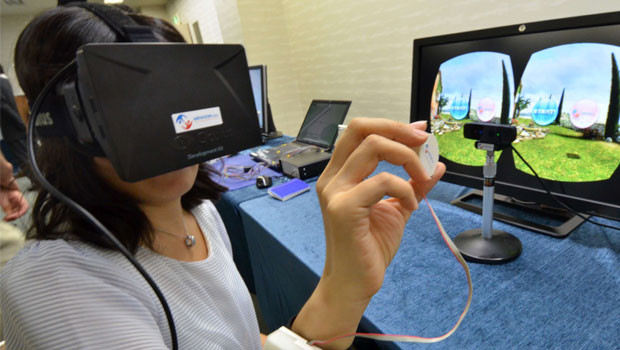New '3D Haptics Touchable 3D Technology' Enables you to Touch 3D images, Boosts Virtual-Reality Gaming

In what could be termed as a potential technology revolution, researchers at Japan's Miraisens, a high-tech firm, have unveiled a new technology, which makes it possible to touch 3D images, by generating customised 'touchable 3D-imagery'.
The brains behind the 'Touchable 3D technology' claim that people will be able to push and pull objects that are visible only on the monitor attached to a computer system.
Researchers also state that this technology will soon be made commercial; to aid people in effectively performing various tasks involving virtual reality.
"This technology will give you a sense that you can touch objects in the 3D world," said Mr Natsuo Koda, chief-executive officer at Miraisens, to AFP Japan.
Working
The 'touchable 3D technology', more generally called "3D-Haptics technology" combines 3D images that are visible to the eye, with multiple vibration patterns generated by a miniature device fitted to the users' fingertip.
According to Mr Norio Nakamura, chief technical officer at Miraisens, 3D-Haptics virtually fools the brain.
"It works by fooling the brain, blending the images the eye is seeing with different patterns of vibration created by a small device on the fingertip," adds Mr Nakamura.
Also, various "virtual buttons" are created for users to work with, to get a feel of the 3D images.
The company also showcased a prototype of the 3D Haptics technology, and this prototype constituted a head-mounted display, which users are required to wear. Virtual buttons (as explained above) are created.
"Users can feel resistance from virtual buttons that he or she is pushing," say engineers at Miraisens.
Effective Gaming
3D-Haptics technology is highly expected to boost the entire virtual reality focussed gaming experience. Engineers at Miraisens say that if the technology is built in within future game controllers, 3D Haptics would enhance gaming, by providing a 'sense of resistance' as a response to specific in-game actions.
In 3D Printing
"It could also be used to make up complicated data that could be fed into a 3D printer, allowing a child to make a virtual dinosaur model and then watch it come into existence," they say.
Along with the above, Miraisens' "3D Haptics Technology" is also expected to aid surgeons in performing surgeries remotely, along with helping the visually impaired in various day-to-day activities.
© Copyright IBTimes 2025. All rights reserved.




















